A number of sustainable agriculture approaches, and their supporting narratives, have been put forward over the decades in attempts to weaken the stronghold of industrial agriculture in the food system. Recent interest has centred on regenerative agriculture, with some of its proponents seeing in its appeal to farmers and corporations an ability to unite disparate agricultural approaches in a manner that might facilitate increasing ambition. In this essay drawing from recent research, Anja Bless compares the genealogical histories of organic agriculture, sustainable intensification, conservation agriculture and agroecology with regenerative agriculture, finding elements within each that resist absorption under the regenerative umbrella.
About the author: Anja Bless is a PhD Candidate at the Institute for Sustainable Futures, University of Technology Sydney. Her PhD research is exploring the politics of regenerative agriculture, with Australia as the national case study. A component of this research project is exploring the origins of regenerative agriculture, in particular the social-ecological factors that have driven its rise in popularity and how it fits among existing sustainable agriculture narratives. Anja holds a Bachelor of Arts (Honours) in Government and International Relations and Sociology from the University of Sydney, and a Master of Environment (with Distinction) majoring in Sustainable Food Systems from the University of Melbourne.
Introduction
The global agri-food system is facing a range of social-ecological threats. Global land degradation, water and biodiversity loss, climate change, and depleting biogeochemical flows are all driven by unsustainable agricultural productionIPCC, “Climate Change and Land: An IPCC Special Report on Climate Change, Desertification, Land Degradation, Sustainable Land Management, Food Security, and Greenhouse Gas Fluxes in Terrestrial Ecosystems” (United Nations, August 7, 2019), https://www.ipcc.ch/site/assets/uploads/2019/08/4.-SPM_Approved_Microsite_FINAL.pdf.. Corporate power and influence in global food governanceJennifer Clapp, “The Problem with Growing Corporate Concentration and Power in the Global Food System,” Nature Food 2 (2021): 404–8, https://doi.org/10.1038/s43016-021-00297-7., the ongoing marginalisation of smallholder farmers and indigenous peoples and knowledge, and the cost-price pressures for producers are also perpetuating social injusticeLucy Jarosz, “Comparing Food Security and Food Sovereignty Discourses,” Dialogues in Human Geography 4, no. 2 (June 25, 2014): 168–81, https://doi.org/10.1177/2043820614537161..
One of the key drivers of these challenges is the dominance of industrial agriculture, a type of intensive farming that frames the farm as a factory, extracting maximum production from agroecosystems by using a high level of chemical and mechanical inputsLeo Horrigan, Robert S. Lawrence, and Polly Walker, “How Sustainable Agriculture Can Address the Environmental and Human Health Harms of Industrial Agriculture.,” Environmental Health Perspectives 110, no. 5 (2002): 445–56, https://doi.org/10.1289/ehp.02110445..
In an effort to address the impacts of industrial agriculture, a range of sustainable agriculture narratives have emerged over time advocating for different approaches to agricultural production. ‘Narratives’ are the stories and labels that frame and unite agricultural movementsChristophe Béné et al., “When Food Systems Meet Sustainability – Current Narratives and Implications for Actions,” World Development 113 (January 2019): 116–30, https://doi.org/10.1016/j.worlddev.2018.08.011., principles, and practices, and capture key events and actorsMolly D Anderson and Marta Rivera-Ferre, “Food System Narratives to End Hunger: Extractive versus Regenerative,” Current Opinion in Environmental Sustainability 49, no. 2 (2020): 18–25, https://doi.org/10.1016/j.cosust.2020.12.002. involved in their creation and development. They bring separate parts of a phenomenon into a cohesive wholeDavid M. Kaplan, “Narratives of Food, Agriculture, and the Environment,” in The Oxford Handbook of Environmental Ethics, ed. Stephen M. Gardiner and Allen Thompson, 1st ed. (Oxford University Press, 2016), https://doi.org/10.1093/oxfordhb/9780199941339.013.36., and are deployed to help justify particular actions and to create pathways for changeChristopher Luederitz et al., “Many Pathways toward Sustainability: Not Conflict but Co-Learning between Transition Narratives,” Sustainability Science 12, no. 3 (2017): 393–407, https://doi.org/10.1007/s11625-016-0414-0.. However, despite the long legacies of these sustainable agriculture narratives, and their ever-growing number, industrial agriculture prevails.
The latest sustainable agriculture narrative to rise to prominence is that of regenerative agriculturePeter Newton et al., “What Is Regenerative Agriculture? A Review of Scholar and Practitioner Definitions Based on Processes and Outcomes,” Frontiers in Sustainable Food Systems 4 (2020), https://doi.org/10.3389/fsufs.2020.577723., which some view as an umbrella term that can unite disparate visions of sustainable agriculture to finally tackle industrial agricultureMadison Seymour and Sean Connelly, “Regenerative Agriculture and a More-than-Human Ethic of Care: A Relational Approach to Understanding Transformation,” Agriculture and Human Values, 2022, https://doi.org/10.1007/s10460-022-10350-1.. New research recently published by myself and my colleagues, Dr Federico Davila and Dr Roel Plant, demonstrates some of the flaws in this assumption and the risks in promoting regenerative agriculture as a catch-all solution.
To contextualise the rise of regenerative agriculture and unpack its potential to overcome industrial agriculture, we undertook a genealogical analysisDavid Garland, “What Is a ‘History of the Present’? On Foucault’s Genealogies and Their Critical Preconditions,” Punishment & Society 16, no. 4 (2014): 365–84, https://doi.org/10.1177/1462474514541711. of the ‘narratives’ that have formed around other existing sustainable agriculture approaches: organic agriculture, conservation agriculture, sustainable intensification, and agroecology. A genealogical analysis is a ‘history of the present’, whereby a critical lens – one that seeks to uncover and challenge power structures – is applied to the past in order to question the narratives of the presentDonnelly Michael, “Foucault’s Genealogy of the Human Sciences,” Economy and Society 11, no. 4 (1982): 363–80, https://doi.org/10.1080/03085148200000013.. We explored the origins of these four narratives and their approaches to sustainable agriculture, how these narratives have changed and morphed over time, and their current state in relation to regenerative agriculture.
Organic agriculture
The first sustainable agriculture narrative whose genealogy we explored is that of organic agriculture. This emerged in inter-war Europe, the UK, and the USA as an agrarian response to urbanisation driven by the Industrial Revolution and the mechanisation of agricultureG. Vogt, “The Origins of Organic Farming,” in Organic Farming: An International History, ed. William Lockeretz (Wallingford, UK ; Cambridge, MA: CABI, 2007), 9–29.. There was concern among farmers and farmer associations around the impacts of industrial agriculture in terms of soil health and chemical pollution, and the ‘de-ruralisation’ of societyKaplan, “Narratives of Food, Agriculture, and the Environment.”. Better scientific understanding of the role of micro-organisms in soil health helped drive the view that the farm should be seen as a living systemVogt, “The Origins of Organic Farming.”. When the term ‘organic agriculture’ was coined in 1940 by UK-based Lord Northbourne, he argued for a form of agriculture which did not rely on external inputs or treat the land as an inanimate resource to be exploited. Instead, he stated that “the farm itself must have a biological completeness; it must be a living entity, it must be a unit which has within itself a balanced organic life”Lord Christopher James Northbourne, Look to the Land, 2nd ed. (Hillsdale NY: Sophia Perennis, 2003), 58..
Organic agriculture remained relatively on the fringe through the war and post-war years when focus was on food shortages and maximising agricultural output. But in the 1960s, concerns began to grow around the use of synthetic chemicals in food production, spurred by Rachel Carson’s Silent SpringW. Lockeretz, “What Explains the Rise of Organic Farming?,” in Organic Farming: An International History, ed. William Lockeretz (Wallingford, UK ; Cambridge, MA: CABI, 2007), 1–8.. Environment and counter-cultural movements helped drive organic agriculture’s customer base and a series of scandals around false claims of ‘organic’ produce led to the development of organic standards and certifications, which underpin organic agriculture to this dayO. Schmid, “Development of Standards for Organic Farming,” in Organic Farming: An International History, ed. William Lockeretz (Wallingford, UK ; Cambridge, MA: CABI, 2007), 152–74.. Organic agriculture continued to build momentum over the next forty years, with organic produce now commonplace on mainstream supermarket shelvesJ. Aschemann et al., “The Organic Market,” in Organic Farming: An International History, ed. William Lockeretz (Wallingford, UK ; Cambridge, MA: CABI, 2007), 123–51.. By the 1980s, Global North producers could not keep up with demand, and the Global South quickly became the main export market for organic produce to European and North American consumersN. Parrott, J. E. Olesen, and H. Høgh-Jensen, “Certified and Non-Certified Organic Farming in the Developing World.,” in Global Development of Organic Agriculture: Challenges and Prospects, ed. N. Halberg et al. (Wallingford: CABI, 2006), 153–79, https://doi.org/10.1079/9781845930783.0153.. The increased demand and scale of production led to a focus on efficiency, and organic farms ‘conventionalised’ as they became more monocultural and reliant on organic inputs through the 1990s and 2000sIka Darnhofer et al., “Conventionalisation of Organic Farming Practices: From Structural Criteria towards an Assessment Based on Organic Principles. A Review,” Agronomy for Sustainable Development 30, no. 1 (2010): 67–81, https://doi.org/10.1051/agro/2009011..
This conventionalisation of organic agriculture, paired with the strictness of organic standard setting that increasingly focussed on avoiding the use of synthetic inputs, embodies what is now labelled ‘Organic 2.0’. In this form, the organic agriculture narrative came to mimic much of what it originally opposed, evolving into a market niche within the industrial regime. In response, the International Federation of Organic Agriculture Movements (IFOAM) has called for a shift to ‘Organic 3.0’M. Arbenz, D. Gould, and C. Stopes, “Organic 3.0 - for Truly Sustainable Farming and Consumption.,” Organic 3.0 - for Truly Sustainable Farming and Consumption., 2016, http://www.cabdirect.org/cabdirect/abstract/20173071820. which aims to return to the holistic and ecologically oriented principles on which organic agriculture was founded. ‘Organic 3.0’ also emphasises notions of food justice, addressing issues of inequity in the organic supply chain. It takes into consideration social issues beyond the farm-gate by partnering with agroecology, fair trade, smallholder and family farm movements. Organic 3.0’s broader uptake and the impacts of this shift are yet to be seen.
Conservation agriculture
Conservation agriculture originated from similar concerns to organic agriculture regarding soil health and land degradation. The Dust Bowl Crisis of the 1930s in the USA, where traditional tilling practices implemented on an industrial scale had caused widespread soil loss and dust stormsKen E. Giller et al., “Beyond Conservation Agriculture,” Frontiers in Plant Science 6 (2015): 1–14, https://doi.org/10.3389/fpls.2015.00870., was a prominent source of this concern. Rather than calling for a return to more traditional, nature-based methods however, conservation agriculture instead promoted new technologies as the solution. These technologies came in the 1940s with the invention of 2,4-D, a broadleaf weed killerRolf Derpsch, “Historical Review of No-Tillage Cultivation of Crops,” in Proceedings of the 1st JIRCAS Seminar on Soybean Research on No-Tillage Culture & Future Research Needs, vol. 13 (JIRCAS Seminar on Soybean Research on No-Tillage Culture & Future Research Needs, Iguassu Falls, Brazil: JIRCAS, 1998), 1–18., and direct drilling technologyA. Kassam, T. Friedrich, and R. Derpsch, “Global Spread of Conservation Agriculture,” International Journal of Environmental Studies 76, no. 1 (2019): 29–51, https://doi.org/10.1080/00207233.2018.1494927., allowing the reduction or elimination of tillage.
The revolution of no-till farming also became the bedrock for some of the world’s most powerful agri-food corporations. Dow Chemical, one of the world’s largest agricultural input firmsClapp, “The Problem with Growing Corporate Concentration and Power in the Global Food System.”, demonstrated the first successful application of no-till techniques in 1951Derpsch, “Historical Review of No-Tillage Cultivation of Crops.”. Similarly, John Deere, which has a 20% market share in the global agricultural equipment marketMercedes Chien, “John Deere: Business Breakdowns Research” (Colossus, LLC, 2021)., worked with US farmers in 1953 to test direct drilling technologyG. B. Triplett and Warren A. Dick, “No-Tillage Crop Production: A Revolution in Agriculture!,” Agronomy Journal 100 (2008): S153–65, https://www.proquest.com/docview/194515641/citation/FA67E80862A746CAPQ/1..
In the 1980s, global concern regarding soil loss helped bolster the spread of no-till agriculture practices from the USA to Latin AmericaDerpsch, “Historical Review of No-Tillage Cultivation of Crops.”, and by the 1990s the UN began endorsing what was termed ‘conservation tillage’. In 2001, the FAO adopted the term ‘conservation agriculture’Amir Kassam et al., “The Spread of Conservation Agriculture: Justification, Sustainability and Uptake,” International Journal of Agricultural Sustainability 7, no. 4 (2009): 292–320, http://www.proquest.com/docview/214038096/abstract/9C80C030597B474APQ/1., defining it as being based on three principles: minimum mechanical soil disturbance, permanent soil cover, and species diversificationFAO, “Conservation Agriculture” (Plant Production and Protection Division, Food and Agriculture Organization of the United Nations, 2017), https://www.fao.org/3/i7480e/i7480e.pdf..
Further calls to address land degradation in the UN’s 2005 Millennium Ecosystem Assessment helped drive the spread of conservation agriculture and its ‘soil conserving’ practices further across Latin America, Oceania, East Asia, and EuropeAmir Kassam et al., “The Spread of Conservation Agriculture: Policy and Institutional Support for Adoption and Uptake,” Field Actions Science Reports 7 (2014): 1–12.. This was also supported by the release of herbicide-resistant genetically modified crops in the 1990s, which further reduced the need for tillage to reduce weeds and improved productivityGiller et al., “Beyond Conservation Agriculture.”, once again demonstrating the role of agri-food corporations in the spread of conservation agriculture. It is estimated that 12.5% of global cropland is managed using conservation agriculture practicesKassam, Friedrich, and Derpsch, “Global Spread of Conservation Agriculture.”, with further support coming from its mitigation potential in reducing soil carbon loss by minimising soil disturbance and maintaining soil coverKassam et al., “The Spread of Conservation Agriculture.”.
The sustainability of conservation agriculture has been questioned by scholars due to the strong involvement of agri-food corporations in driving the spread of this narrative and its technologically intensive and high input practices. Some argue that conservation agriculture is simply industrial agriculture by another name, and that its limited applicability outside cropping systems means it is not a system-wide solutionGiller et al., “Beyond Conservation Agriculture.”.
Sustainable intensification
Another technology-oriented narrative is sustainable intensification, an ecomodernist approach that was triggered by concerns in the 1990s around how to feed a growing world population - a worry that re-emerged during the global food price crisis in 2007/8.
While industrial agriculture had succeeded in producing more food than ever before, the FAO’s World Food Summit in 1996 called for a new round of agricultural intensification to feed the projected increase in global population. There was also increasing interest in sustainability following the publication of the UN-led Brundtland Report in 1987 and its concept of ‘sustainable development’Meike Weltin et al., “Conceptualising Fields of Action for Sustainable Intensification-A Systematic Literature Review and Application to Regional Case Studies,” Agriculture Ecosystems & Environment 257 (2018): 68–80, https://doi.org/10.1016/j.agee.2018.01.023.. An alignment was sought between improving environmental outcomes whilst enhancing productivityDouglas H. Constance and Athena Moseley, “Agrifood Discourses and Feeding the World: Unpacking Sustainable Intensification,” in Contested Sustainability Discourses in the Agrifood System, ed. Douglas H. Constance, Jason T. Konefal, and Maki Hatanaka (London: Routledge/Earthscan, 2018), 59–74, https://www.taylorfrancis.com/books/e/9781351664929/chapters/10.4324%2F9781315161297-11..
While the term ‘sustainable intensification’ was coined in 1997Jules N. Pretty, “The Sustainable Intensification of Agriculture,” Natural Resources Forum 21, no. 4 (1997): 247–56, https://doi.org/10.1111/j.1477-8947.1997.tb00699.x., it remained largely unused through the 2000s until the global food price crisis of 2007/8H. Charles J. Godfray, “The Debate over Sustainable Intensification,” Food Security 7, no. 2 (2015): 199–208, https://doi.org/10.1007/s12571-015-0424-2.. To address food shortages, institutions such as the World Trade Organisation called for a sustainable intensification of agricultureMichael Cardwell and Fiona Smith, “Renegotiation of the WTO Agreement on Agriculture: Accommodating the New Big Issues,” International & Comparative Law Quarterly 62, no. 4 (October 2013): 865–98, https://doi.org/10.1017/S0020589313000341.. In response, the UK’s Royal Society published a report advocating for sustainable intensification which it defined as “global agriculture in which yields are increased without adverse environmental impact and without the cultivation of more land”The Royal Society, Reaping the Benefits: Science and the Sustainable Intensification of Global Agriculture (London: The Royal Society, 2009), ix.. The idea of sustainable intensification ‘doing more with less’ was attractive as a means of sparing land from conversion to agriculture and thanks to the biodiversity and mitigation benefits that could bringLes Levidow, “Sustainable Intensification: Agroecological Appropriation or Contestation?,” in Contested Sustainability Discourses in the Agrifood System, ed. Douglas H. Constance, Jason T. Konefal, and Maki Hatanaka (London: Routledge/Earthscan, 2018), 19–41, https://www.taylorfrancis.com/books/e/9781351664929/chapters/10.4324%2F9781315161297-11.. The call for sustainable intensification was echoed by the FAOFAO, “How to Feed the World in 2050,” Expert Paper (Rome: FAO, 2009), https://www.fao.org/fileadmin/templates/wsfs/docs/expert_paper/How_to_Feed_the_World_in_2050.pdf., and driven by government and private funding, particularly in aid and development programs from the US, UK, and EuropeBrian Petersen and Sieglinde Snapp, “What Is Sustainable Intensification? Views from Experts,” Land Use Policy 46 (2015): 1–10, https://doi.org/10.1016/j.landusepol.2015.02.002..
However, criticisms of sustainable intensification’s high-input nature, its echoes of the Green Revolution in terms of Global North-South dynamics, and the involvement of corporate actors have become louderGodfray, “The Debate over Sustainable Intensification.”. Sustainable intensification has now been dismissed by many as being too business-as-usual. Since its peak in public and private attention in 2015-16, the narrative seems to have fallen out of fashionWeltin et al., “Conceptualising Fields of Action for Sustainable Intensification-A Systematic Literature Review and Application to Regional Case Studies.”.
Agroecology
Agroecology emerged out of more progressive scientific understandings of the farm, and in retaliation against the impacts of the Green Revolution. The term ‘agroecology’ emerged in Europe in the 1930s as a combination of the disciplines of ecology and agronomyA. Wezel and V. Soldat, “A Quantitative and Qualitative Historical Analysis of the Scientific Discipline of Agroecology,” International Journal of Agricultural Sustainability 7, no. 1 (2009): 3–18, https://doi.org/10.3763/ijas.2009.0400.. Viewing the farm as an ‘agroecosystem’ became gradually accepted in the ecology discipline from the late 1960s onwardsC. Francis et al., “Agroecology: The Ecology of Food Systems,” Journal of Sustainable Agriculture 22, no. 3 (July 17, 2003): 99–118, https://doi.org/10.1300/J064v22n03_10..
Simultaneously, the peasant agriculture movement in Latin America was drawing attention to the social and environmental impacts of industrial agriculture and was calling for a return to the ecological principles of indigenous and traditional agricultural productionA. Wezel et al., “Agroecology as a Science, a Movement and a Practice,” Agronomy for Sustainable Development 29 (2009): 503–15, https://doi.org/10.1007/978-94-007-0394-0_3.. The principles and practices associated with many sustainable agriculture narratives can be found in traditional and indigenous cultures around the world which understand how social and ecological outcomes are intertwined and interdependentBrendan Coolsaet, “Towards an Agroecology of Knowledges: Recognition, Cognitive Justice and Farmers’ Autonomy in France,” Journal of Rural Studies 47 (October 1, 2016): 165–71, https://doi.org/10.1016/j.jrurstud.2016.07.012.. However, the origins of this mindset are not recognised by the Global North narratives described above. Agroecology is distinct among the narratives explored thus far in its acknowledgment of the inherent sustainability of many traditional and indigenous agriculturesMiguel A. Altieri and Victor Manuel Toledo, “The Agroecological Revolution in Latin America: Rescuing Nature, Ensuring Food Sovereignty and Empowering Peasants,” Journal of Peasant Studies 38, no. 3 (July 8, 2011): 587–612, https://doi.org/10.1080/03066150.2011.582947..
Through the 1980s, the agroecology social movement spread across the Global SouthSantiago Sarandon and Mariana Edith Marasas, “Brief History of Agroecology in Argentina: Origins, Evolution, and Future Prospects,” Agroecology and Sustainable Food Systems 41, no. 3–4 (2017): 238–55, https://doi.org/10.1080/21683565.2017.1287808., while agroecology as a discipline began to be taught in Latin American universitiesSteve Gliessman, “Agroecology: Growing the Roots of Resistance,” Agroecology & Sustainable Food Systems 37, no. 1 (2013): 19–31, https://doi.org/10.1080/10440046.2012.736927.. By the 1990s, the call for addressing the power relations that underpin industrial agriculture’s dominance was being heard at an international scaleWezel and Soldat, “A Quantitative and Qualitative Historical Analysis of the Scientific Discipline of Agroecology.”. This cemented the consolidation of the scientific and social movement arms of agroecology, combining the consideration of justice and equity issues in the agri-food system as well as the integration of ecology and agronomyFrancis et al., “Agroecology.”.
Agroecology has attracted a range of supporters as the narrative has risen in prominence, from the peasant advocacy organisation La Via Campesina supporting the role of agroecology in the food sovereignty movementWorld Forum for Food Sovereignty, “Declaration of the Forum for Food Sovereignty, Nyéléni 2007,” 2007, https://nyeleni.org/spip.php?article290., to governments and food agencies in EuropeMarta G. Rivera-Ferre, “The Resignification Process of Agroecology: Competing Narratives from Governments, Civil Society and Intergovernmental Organizations,” Agroecology and Sustainable Food Systems 42, no. 6 (February 26, 2018): 666–85, https://doi.org/10.1080/21683565.2018.1437498., and eventually the FAOEdmundo Barrios et al., “The 10 Elements of Agroecology: Enabling Transitions towards Sustainable Agriculture and Food Systems through Visual Narratives,” Ecosystems and People 16, no. 1 (September 9, 2020): 230–47, https://doi.org/10.1080/26395916.2020.1808705.. While endorsements from Global North institutions may have helped legitimise agroecology in the current world order, the movement’s leaders have been conscious of the risk of co-option, particularly by corporate actorsMaywa Montenegro de Wit and Alastair Iles, “Toward Thick Legitimacy: Creating a Web of Legitimacy for Agroecology,” Elementa: Science of the Anthropocene 4 (2016): 115–38, https://doi.org/10.12952/journal.elementa.000115.. Agroecology advocates for transformation of the agri-food system, including the unequal power dynamics within it. This has led some to question its practicality and palatability in larger-scale and export-oriented farming contextsKees Jansen, “The Debate on Food Sovereignty Theory: Agrarian Capitalism, Dispossession and Agroecology,” The Journal of Peasant Studies 42, no. 1 (2015): 213–32, https://doi.org/10.1080/03066150.2014.945166.. Its challenge to existing power relations in the agri-food system has also led to agroecology advocates being sidelined at key food governance eventsIPES-Food, “Smoke and Mirrors: Examining Competing Framings of Food System Sustainability: Agroecology, Regenerative Agriculture, and Nature-Based Solutions.” (International Panel of Experts on Sustainable Food systems, 2022), http://www.ipes-food.org/pages/smokeandmirrors..
Contextualising the rise of regenerative agriculture
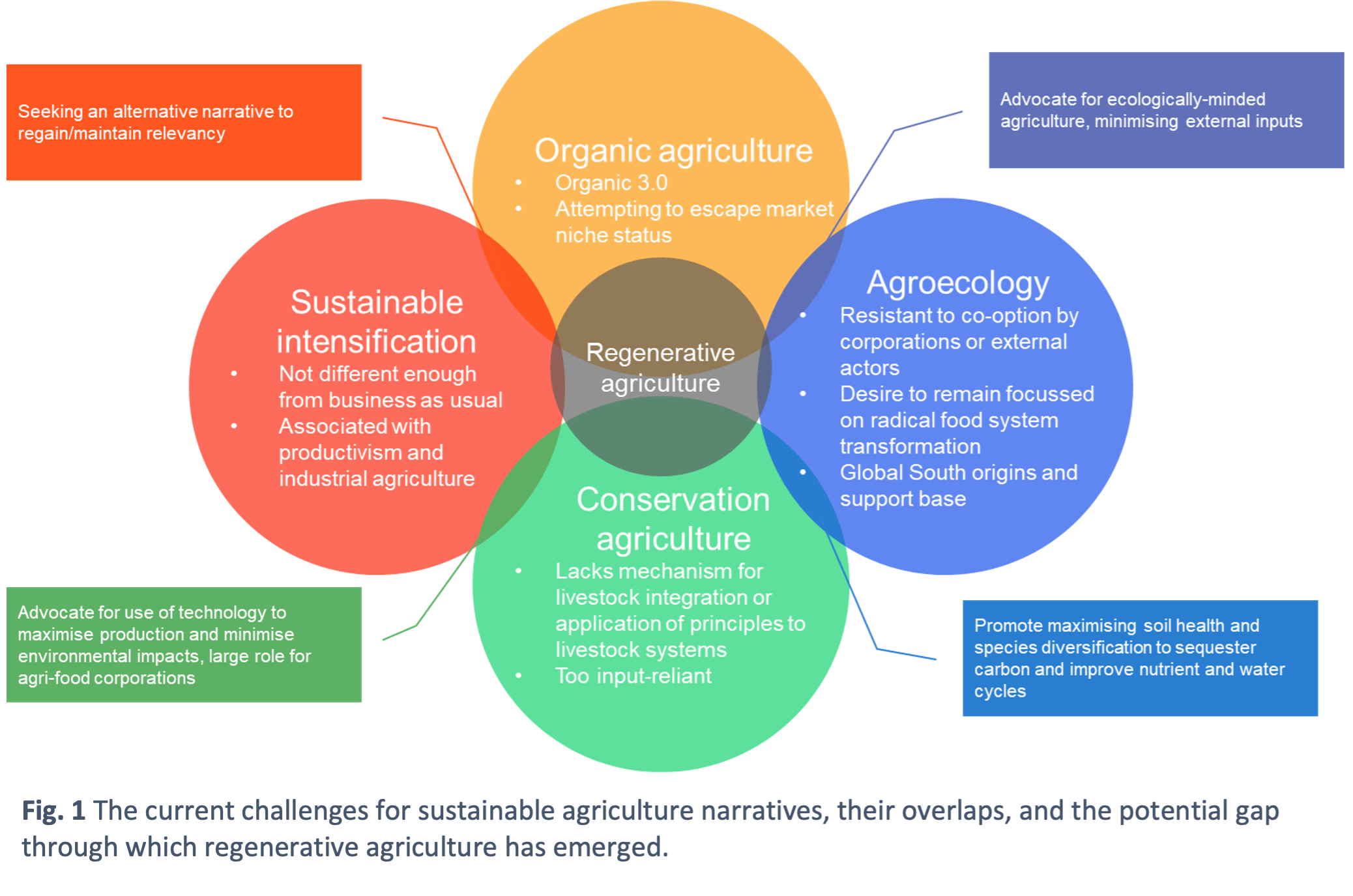
What our analysis of these sustainable agriculture narratives makes clear is that they share similarities and differences (see Figure 1). And it is through the gap left between these contestations and overlaps that regenerative agriculture has emerged to prominence.
The term ‘regenerative agriculture’ was coined in the late 1970s by social scientist Medard Gabel, and the term was soon adopted by The Rodale Institute, a prominent organic agriculture organisation in the USA, who viewed it as agriculture that was ‘beyond organic’. However, regenerative agriculture remained fairly niche up until a recent boom from around 2015 onwards, when research and media mentions skyrocketed, particularly in the US, Australia, New Zealand, and the UKKen E Giller et al., “Regenerative Agriculture: An Agronomic Perspective,” Outlook on Agriculture X, no. X (2021): 1–13, https://doi.org/10.1177/0030727021998063.. The timing of this emergence is interesting as it coincides with the waning popularity of sustainable intensificationWeltin et al., “Conceptualising Fields of Action for Sustainable Intensification-A Systematic Literature Review and Application to Regional Case Studies.”. This may be a coincidence, though it could also indicate that the attention of dominant agri-food system actors, and their conception of sustainable agriculture, has shifted from land sparing to land sharing. The mid-2010s is also when the call for ‘Organic 3.0’ was publishedArbenz, Gould, and Stopes, “Organic 3.0 - for Truly Sustainable Farming and Consumption.”. The term ‘regenerative organic’ is increasingly being used to distinguish between holistic versus conventionalised approaches to organic agricultureEthan Gordon, Federico Davila, and Chris Riedy, “Regenerative Agriculture: A Potentially Transformative Storyline Shared by Nine Discourses,” Sustainability Science, February 6, 2023, https://doi.org/10.1007/s11625-022-01281-1..
Regenerative agriculture’s definition is still a matter for debate, though it is generally understood either as a set of practices, such as minimising soil disturbance, integrating livestock, maximising soil cover, rotational grazing, and lowering external inputsNewton et al., “What Is Regenerative Agriculture?”, or as principles that centre around going ‘beyond sustainability’Leah V. Gibbons, “Regenerative—The New Sustainable?,” Sustainability 12, no. 13 (January 2020): 5483–5501, https://doi.org/10.3390/su12135483. to rejuvenate landscapes and farms through enhancing ecosystem processes such as water, nutrient, and carbon cycles. Sometimes, definitions also include social outcomes such as restoring the health of communities and farmersNewton et al., “What Is Regenerative Agriculture?”.
There are overlaps and differences between the definitions of regenerative agriculture and the narratives we analysed. For instance, minimising soil disturbance and maximising soil cover align with conservation agriculture. However, regenerative agriculture’s inclusion of livestock and mixed systems gives it broader applicability. This is important in a time when there is increasing focus on agriculture’s contributions to climate change, particularly from livestock, and the mitigation potential of soil carbon sequestrationIPCC, “Climate Change and Land: An IPCC Special Report on Climate Change, Desertification, Land Degradation, Sustainable Land Management, Food Security, and Greenhouse Gas Fluxes in Terrestrial Ecosystems.”. Many regenerative agriculture advocates also highlight the need to reduce external inputs in farming, in line with agroecology and organic agriculture principles, and in contrast with conservation agriculture and sustainable intensification. Unlike those for organic agriculture however, not all proponents of regenerative agriculture advocate for a complete removal of synthetic inputs.
While regenerative agriculture might address some of the gaps or challenges faced by existing narratives, it is by no means an umbrella term that can envelop those narratives completely. There remain clear distinctions and differences between them (see Table 1).
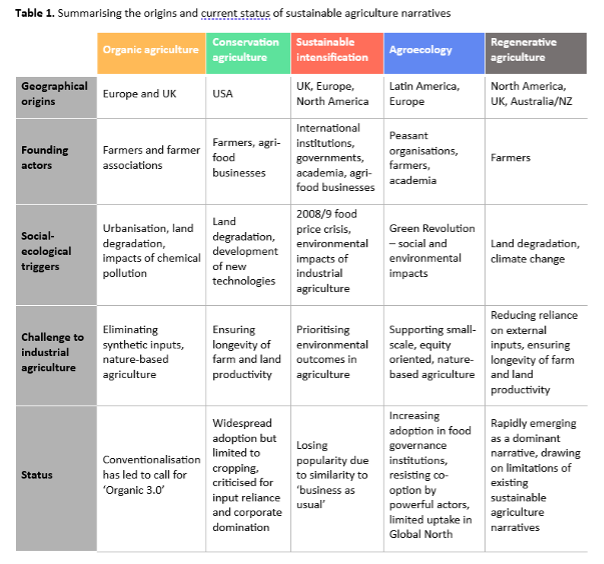
One of the clearest limitations of regenerative agriculture as a concept can be seen in its contrast to that of agroecology. While the concepts share similar farming practices and principles, regenerative agriculture is comparatively lacking in terms of its engagement with power relations and issues of social injustice in the agri-food system. Although farmers have been pivotal in driving the growth of regenerative agriculture, there has also been a prominent role for agri-food corporations, such as Unilever, PepsiCo, and Cargill, which has largely remained unchallengedGordon, Davila, and Riedy, “Regenerative Agriculture.”. Like other Global North narratives, regenerative agriculture has also been critiqued for not recognising the role of indigenous and more diverse knowledges and practitioners in ecologically minded farmingBryony Sands et al., “Moving towards an Anti-Colonial Definition for Regenerative Agriculture,” Agriculture and Human Values, May 4, 2023, https://doi.org/10.1007/s10460-023-10429-3.. There has been some improvement in this area, for example in the US through the increased acknowledgment of Black, LatinX, and Indigenous regenerative farmers and the legacies of their practicesLiz Carlisle, Healing Grounds: Climate, Justice, and the Deep Roots of Regenerative Farming (Washington D.C.: Island Press, 2022).. However, regenerative agriculture remains less holistic than the agroecology narrative, and its increasing popularity among powerful agri-food system actors could risk exacerbating the marginalisation of agroecology’s calls for structural changes in the agri-food system.
Conclusion
While our analysis demonstrated that regenerative agriculture may not be the unifying narrative some purport it to be, there is an argument for encouraging a diversity of sustainable agriculture narratives to usurp the dominance of industrial agriculture and encourage a range of locally appropriate solutionsJames Sumberg and Ken E. Giller, “What Is ‘Conventional’ Agriculture?,” Global Food Security 32 (2022): 100617, https://doi.org/10.1016/j.gfs.2022.100617.. For instance, in some contexts regenerative agriculture might be a steppingstone for mainstream farmers to more ecological farming practicesGordon, Davila, and Riedy, “Regenerative Agriculture.”. Nonetheless, the politics that a plurality of perspectives brings cannot be ignoredIan Scoones et al., “Transformations to Sustainability: Combining Structural, Systemic and Enabling Approaches,” Current Opinion in Environmental Sustainability, Advancing the science of actionable knowledge for sustainability, 42 (February 1, 2020): 65–75, https://doi.org/10.1016/j.cosust.2019.12.004.. The genealogies of sustainable agriculture narratives demonstrate that, to establish a truly sustainable agri-food system, there is a need for ongoing resistance against the power dynamics that could neglect marginalised voices or perpetuate injustice and inequity.
Header image by Alexander Turner.
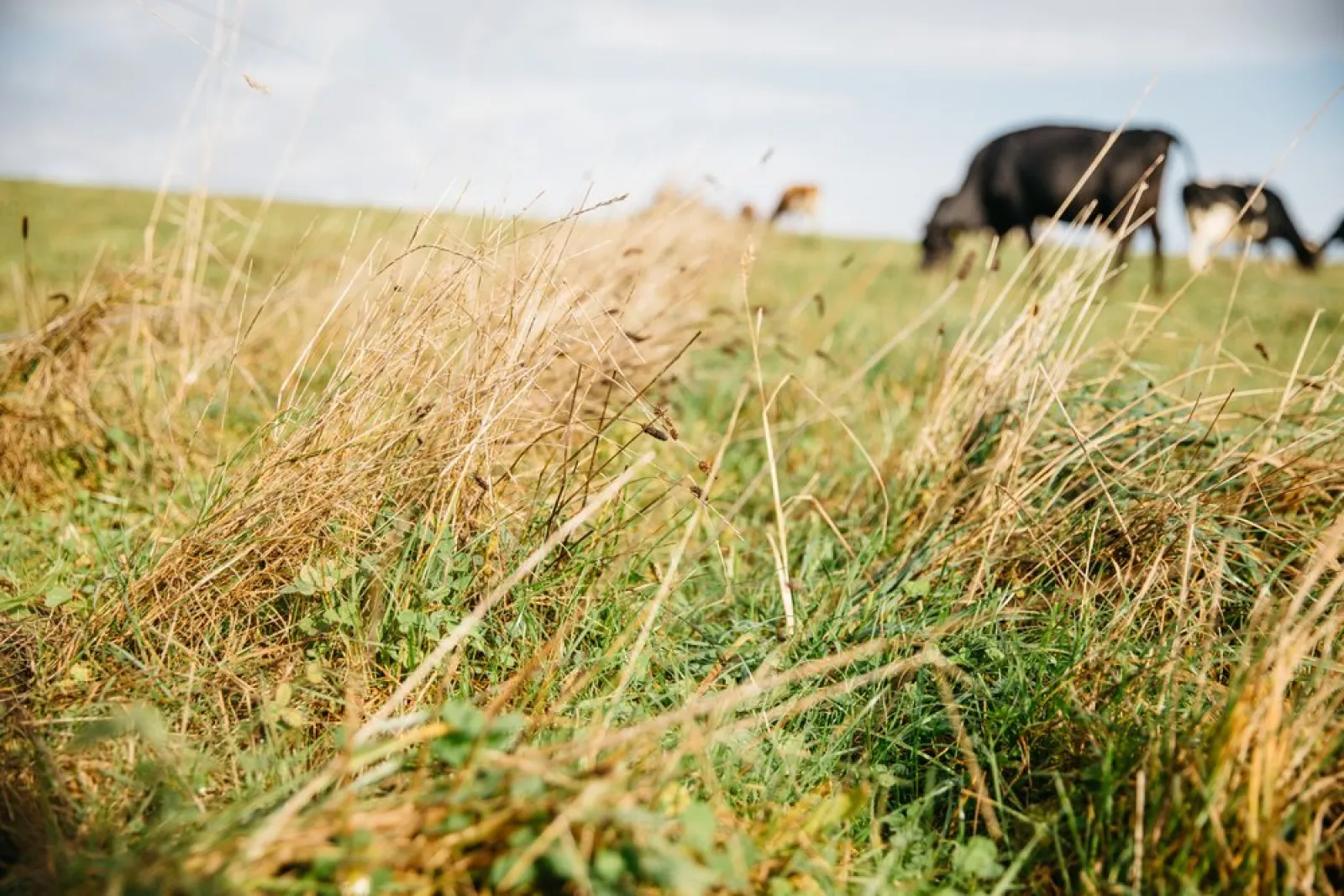
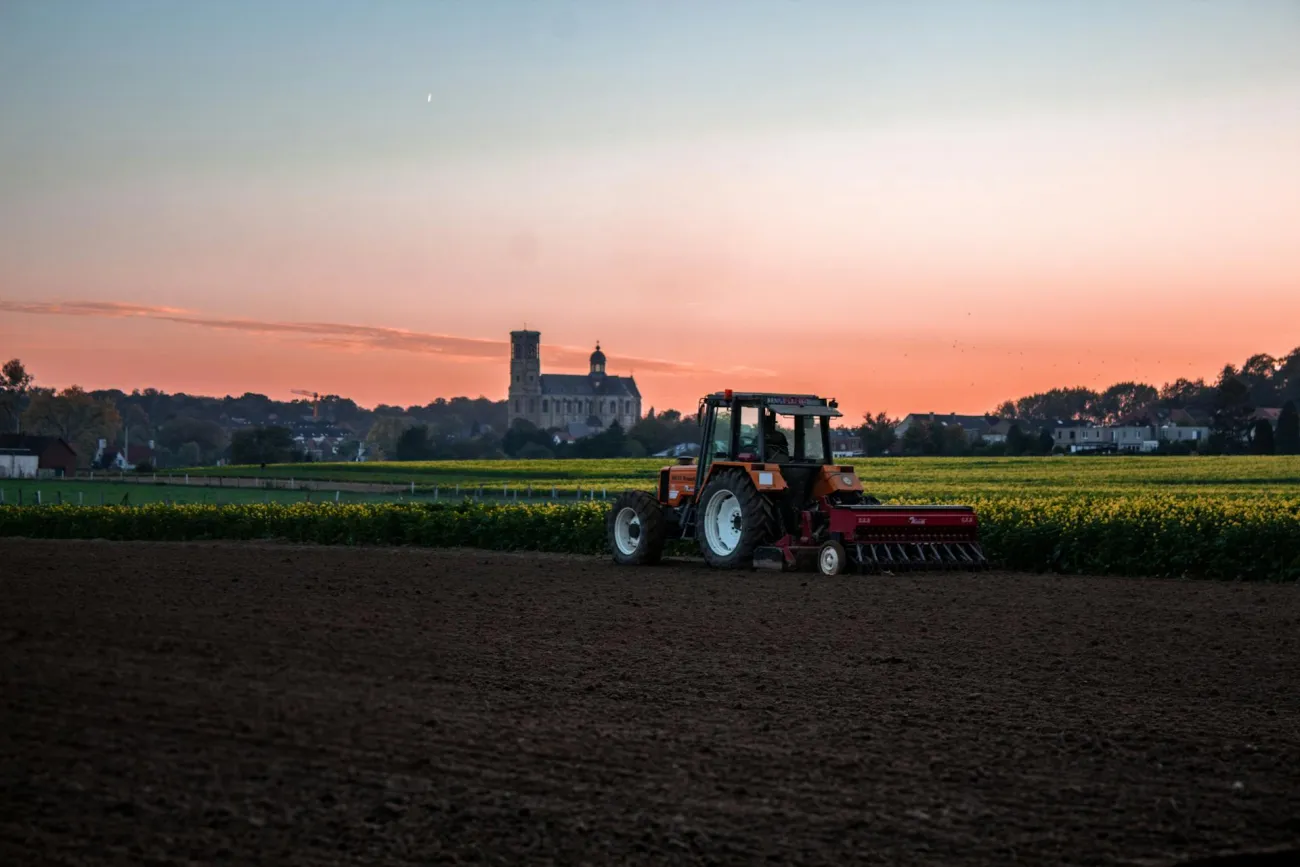
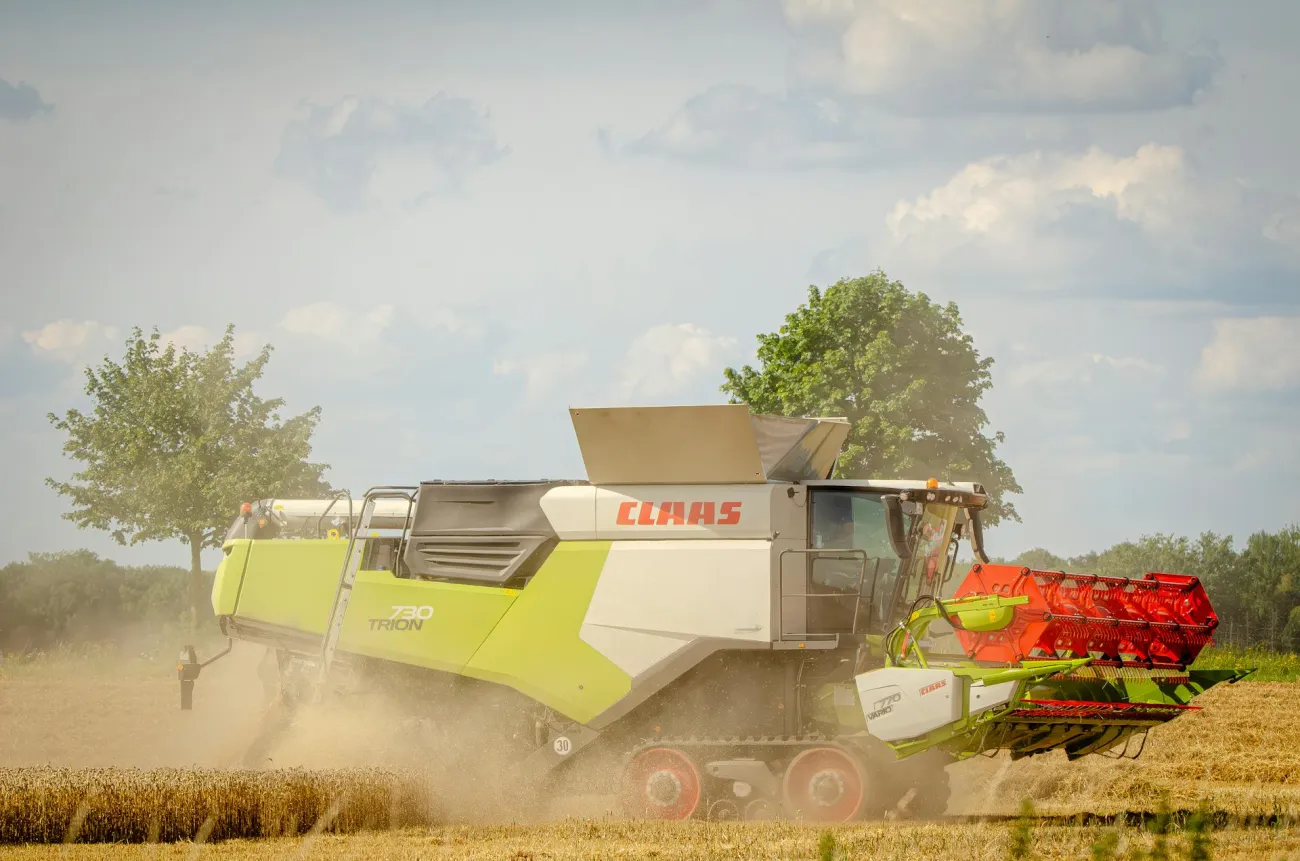
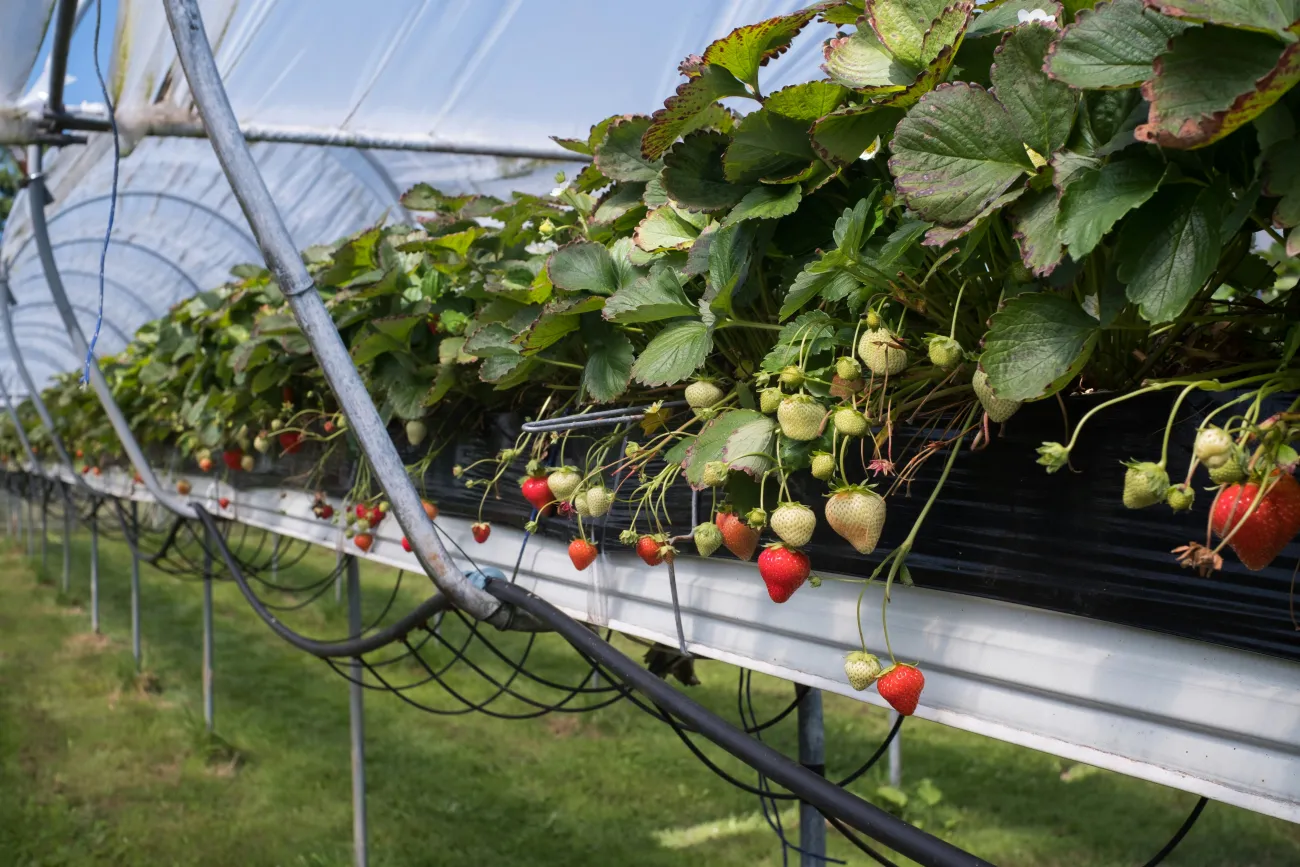
Comments (0)